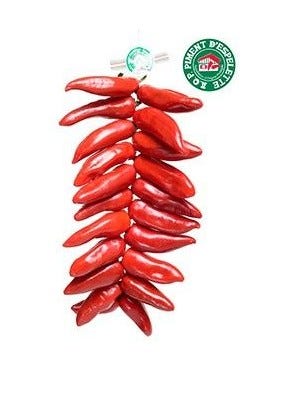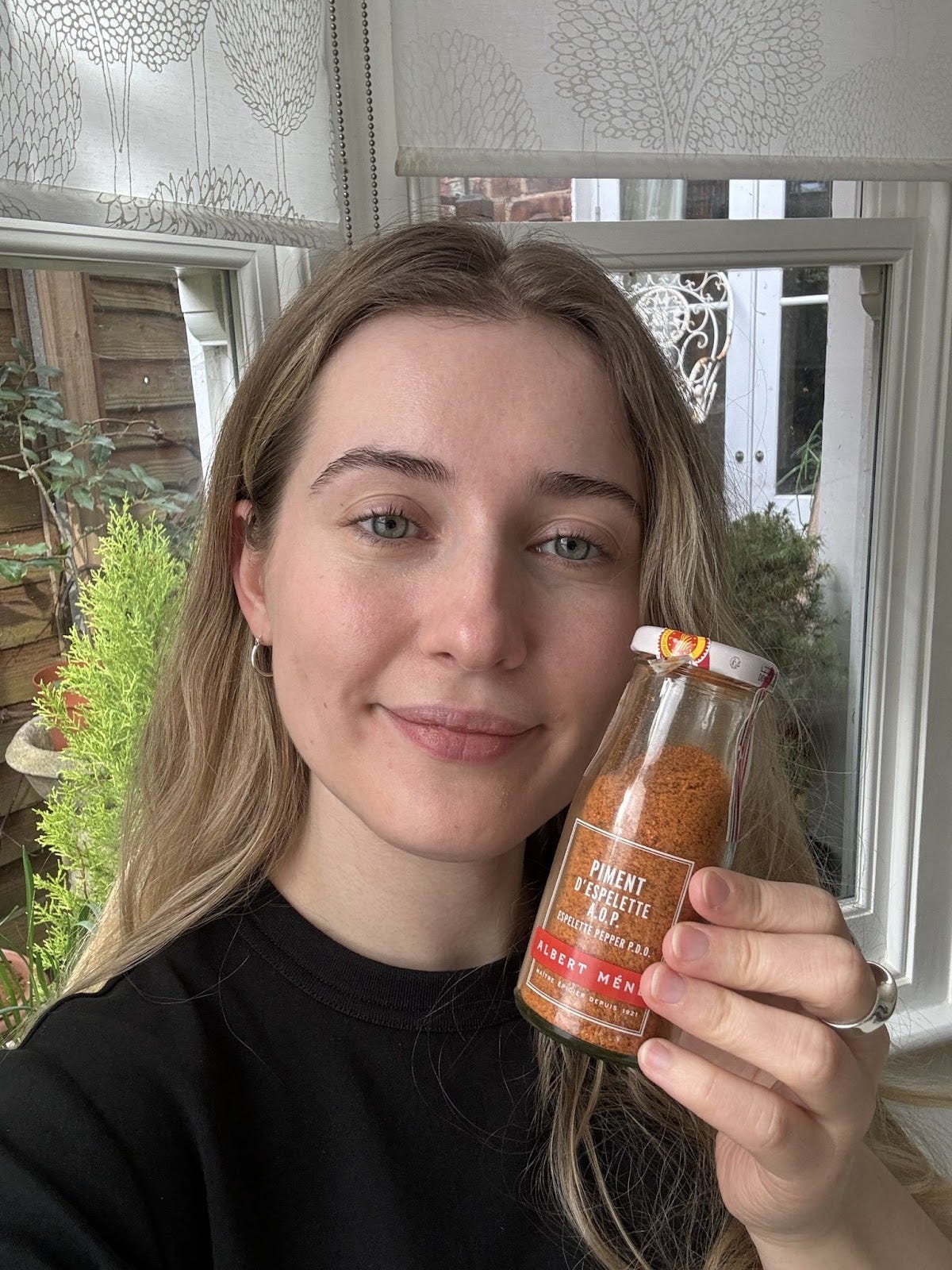Clear The Shelf #5 - Espelette Pepper
This week I explore my overflowing spice drawer and dive deep into the world of Espelette Pepper (Piment d’Espelette)
Welcome to another episode of Clear The Shelf! This week’s ingredient is Espelette Pepper.
Note: I’ve used this product's French and English spellings so far, but I’ll be using the English throughout the newsletter for ease x
What is Espelette Pepper?
Espelette Pepper is a rare pepper grown in the Basque region of southwest France. It takes its name from Espelette, one of the most important towns in the region. (1)
Espelette pepper scores 4,000 units on the Scoville scale (which measures how pungent/spicy chilli peppers are). For comparison, the jalapeño ranges from 2,500 - 8,000 and the cayenne lies at around 30,000 to 50,000 units.
Espelette pepper comes in three ways:
Le frais - The fresh, whole peppers that producers use to create pepper powder and other products
La poudre - The powder form, which it’s most commonly bought as, and what I’m using in this episode
La corde - From 20 to 100 fresh Espelette peppers braided together (as pictured below) (2)

Espelette peppers are rare because they can only be grown and produced in a designated area of France. They were awarded an AOC certification (Appellation d’origine contrôlée) in 2002, ‘which the French government grants to some agricultural products grown or made in certain geographical areas. Two years later, in 2002, the peppers from Espelette were awarded the AOP (Appellation d’Origine Protégée) denomination, the European Union equivalent of AOC.’ (1)
Given its AOP status, only ‘10 communities are allowed to use the name Espelette for the peppers they grow: Espelette, Ainhoa, Cambo-les-Bains, Halsou, Itxassou, Jatxou, Larressore, Saint-Pée-sur-Nivelle, Souraïde and Ustaritz. The total growing area is about 3,000 acres.’(3)
What does Espelette Pepper taste like?
The flavour of Espelette pepper, in powder form, is smoky, fruity, and slightly sweet. Although it’s got a unique flavour, the flavour profile does somewhat resemble Aleppo Pepper (pul biber).
Espelette Pepper - A Brief History
Like many staples, including potatoes and tomatoes, the chilli also hailed from South America, and was introduced to Europe in the 15th and 16th centuries by Spanish and Portuguese ‘explorers’. The exact journey of Espelette pepper to the Basque region of France remains a bit of a mystery.
It’s believed to have been brought over by ‘Gonzalo Percaztegi, a Basque navigator sailing with Christopher Columbus (who) first introduced the pepper to the Basque region, planting them along with corn in the Nive Valley’(3) or by ‘the Spanish navigator Juan Sebastian Elcano following an expedition to America.’ (4)
Initially cultivated by women as an affordable substitute for black pepper, Espelette pepper was used as ‘a spice both for seasoning and preserving meat and ham. Every year women selected pepper seeds for future sowing…(which) gave rise to the Gorria variety, the only farmhouse seed which gives Espelette Pepper.’ (2) The peppers were dried, roasted and ground into powder, a tradition that’s been passed down through generations.
A cooperative was set up in 1983 to professionalise the production of Espelette Pepper, but due to various challenges, this closed down, resulting in the decline and almost disappearance of this rare pepper. Despite this setback, a syndicate of farmers and producers were working hard to make it a viable product again. As it began to rise in popularity, farmers and growers realised that they had a very unique product, one that deserved recognition and protection. They did not want farmers in other regions to grow, for example, paprika and call it Espelette.’ (5)
The pepper's fate turned when it gained official recognition with an AOP in 2000 and a PDO in 2002 (2).
Did you know?
Every year on the last weekend in October, the village of Espelette celebrates La Fête du Piment, the end of the pepper harvest. For two days, this festive, cultural and gourmet event attracts over 20,000 visitors from all over France to discover Basque gastronomy and traditions. The festivities include a Basque-language mass with a blessing of the peppers, concerts and food markets, as well as a parade by the Espelette Pepper brotherhood. (6)
How is Espelette Pepper powder made?
The process involves meticulous steps, starting with selecting seeds from top-performing plants and sowing them in greenhouses in March. After two months, the young plants are moved outdoors to grow from April to mid-July, with the harvest beginning in late August when the peppers turn red. Post-harvest, the peppers are cleaned, sorted, and mainly turned into powder. This involves spreading them on racks or hanging them on cords to dry for at least 15 days, followed by oven-drying, stalk removal, and crushing to create the powder.
Why did I buy Espelette Pepper?
I bought this special ingredient at the culinary mothership known as La Grande Épicérie in Paris. I visited this food department store back in November and could have seriously spent all weekend there. From every herb and spice under the sun to beautifully packaged condiments from across the globe, and not forgetting the TikTok famous Beurre Bordier located in the butter aisle (yes, you read that correctly, there’s a butter aisle), it was everything I could dream of and more. I had been perusing the aisles, admiring the perfect produce and coming to terms with the fact that I couldn’t take everything home when a little bottle of Piment D’Espelette A.O.P from Albert Ménès caught my eye during my final walk through the aisles, and I decided to bring it home.
How To Use Espelette Pepper?
Given that Espelette Pepper is mainly bought and sold in powder form, it’s used like most chilli spices to add heat to a dish. For this episode, I knew I wouldn’t be able to find a recipe that used a generous amount of the product - and frankly, I wouldn’t want it to - this stuff is pricey! My overall aim was to just get to grips with how to use it, so it can become part of my arsenal and eventually be used up.
There was one recipe that kept coming up over and over in my research - Piperade. It’s a mix of stewed peppers, onions and tomatoes which are cooked until sweet and jammy. I added some eggs which I had seen in a few recipes like Chef Club and La Cerise sur le Maillot, and it turned out to be a really tasty dish.
The recipe - Eggs in Piperade (Oeufs en Piperade)
Ingredients
1 large onion, thinly sliced
3 peppers (any apart from green), deseeded and thinly sliced
2 cloves of garlic, peeled and grated
1 tsp Espelette pepper, plus more to season at the end
1 tin of tomatoes (crushed or whole tomatoes) - if using tinned whole tomatoes, blitz these into a liquid before using
Eggs, 2 per person
Parsley, finely chopped
Salt, to season
Olive Oil
Bread, to serve
Method:
Heat the oil in a large frying pan and add the onions. Cook these until they start to soften and become translucent. Sprinkle with the tsp of Espelette pepper, stir and cook for a further few minutes.
Pop your sliced peppers into the pan and cook until they start to soften and become jammy.
Add in the grated garlic, season the mixture with salt and stir everything well.
When the peppers and onions are super soft, add in the tinned tomatoes, stir again and cook until some of the liquid has reduced.
Make a few wells in the mixture, crack in some eggs and cook these for about 5 or so minutes.
Plate up and top with some chopped parsley, a sprinkle of Espelette pepper and a chunky slice of bread to mop up the sauce.
You can see me make the full recipe on my TikTok and Instagram!
Other uses for Espelette Pepper
Make your own Espelette Pepper butter - add a few teaspoons to your homemade butter with a few pinches of good-quality salt, before the shaping and storing steps. If you don’t fancy making your own, just add a few tsp to the shop-bought stuff to create a compound butter.
Add a nice hint of spice to aligot, a classic French cheesy potato dish. Felicity Cloake’s recipe breaks down a classic aligot helpfully. Just add in a tsp or two right at the end with the other seasonings.
This spaghetti with anchovies and piment d’Espelette would make the perfect weeknight dinner
What else do you think Espelette Pepper could be good for? I’d love to hear your suggestions!
Should I buy Espelette Pepper?
You likely don’t need to buy Espelette Pepper, but it offers a unique, complex flavour that differs from regular chilli flakes. If you enjoy cooking and experimenting with spices, Espelette Pepper, despite its higher cost, can be a great addition to your kitchen.
It’s not something I’d restock on the weekly food shop but it can be a special treat or works as a thoughtful gift for someone who appreciates gourmet ingredients. I’ll be using it pretty interchangeably with my Aleppo Pepper, but as that’s almost finished, I know I won’t need to rush out to replace it while I’ve got my Espelette knocking about.
Until next time on Clear the Shelf…
I’m going to be taking a few weeks off from Clear The Shelf, ready to bring you some more creative ways to use up the products that have been lingering in my cupboards. But don’t fret, I’ll still be writing some other newsletters in that time!
In the meantime, be sure to check out my TikTok and Instagram for more content!
Thanks,
Izzy x
Sources:







